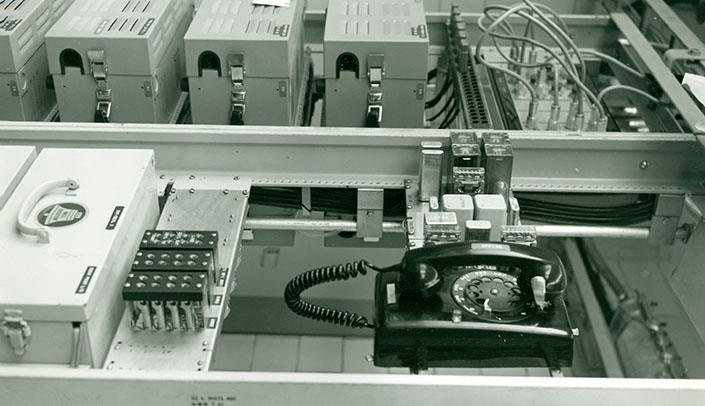How were distance classes taught before the internet?
Before UNMC used Zoom and e-learning modules, faculty and distance students interacted through a two-way closed-circuit television (CCTV) system. The College of Nursing set up a CCTV system to connect the Omaha and Lincoln campuses and launched the first classes in fall 1976.
UNMC was the national innovator in telemedicine. In 1963, Cecil Wittson, M.D., director of the Nebraska Psychiatric Institute (NPI), established the nation’s first CCTV system between NPI and the Norfolk State Mental Hospital. Leaders of the UNMC Department of Biomedical Communications recognized that if the technology could be used to consult on psychiatric cases, it could also be used to teach classes.
With an initial investment of $55,000, the College of Nursing remodeled a classroom and conference room on the University of Nebraska at Lincoln campus. In 1976, UNMC opened the new College of Nursing building in Omaha, designed with eleven rooms equipped to film and transmit classes.The College of Nursing also purchased color television cameras, receivers, microphones, audio mixers, and most importantly established the telephony links between Omaha and Lincoln.
The College of Nursing contracted with Nebraska Educational Television (Nebraska ETV) and Northwestern Bell Telephone Company to provide video and audio connections. The “links” traveled from UNMC to the University of Nebraska at Omaha interconnection to a transmitter in Mead, Neb., to the Nebraska ETV center and then into the UNL classroom.
The CCTV system allowed the College of Nursing to be one college in two locations. The college expanded course offerings, shared media and teaching resources, shared instructors, coordinated administration, and increased committee membership and participation.
Teaching over CCTV required instructors to plan to use materials that were suitable for viewing on televisions. Students found color transparencies impactful. Instructors created handouts and sent them through intra-campus mail ahead of the class meeting. When the microphones were working well, the instructors and students could have meaningful class discussions. Students who completed the distance classes scored just as high on exams as the students in Omaha.
The biomedical communications department was instrumental in launching the College of Nursing’s innovative, state-of-the-art instruction. Reba Benschoter, Ph.D., head of biomedical communications, also helped the College of Nursing film and distribute classes taught by College of Medicine instructors in physiology, microbiology, and biochemistry for use by College of Nursing students throughout the state.
